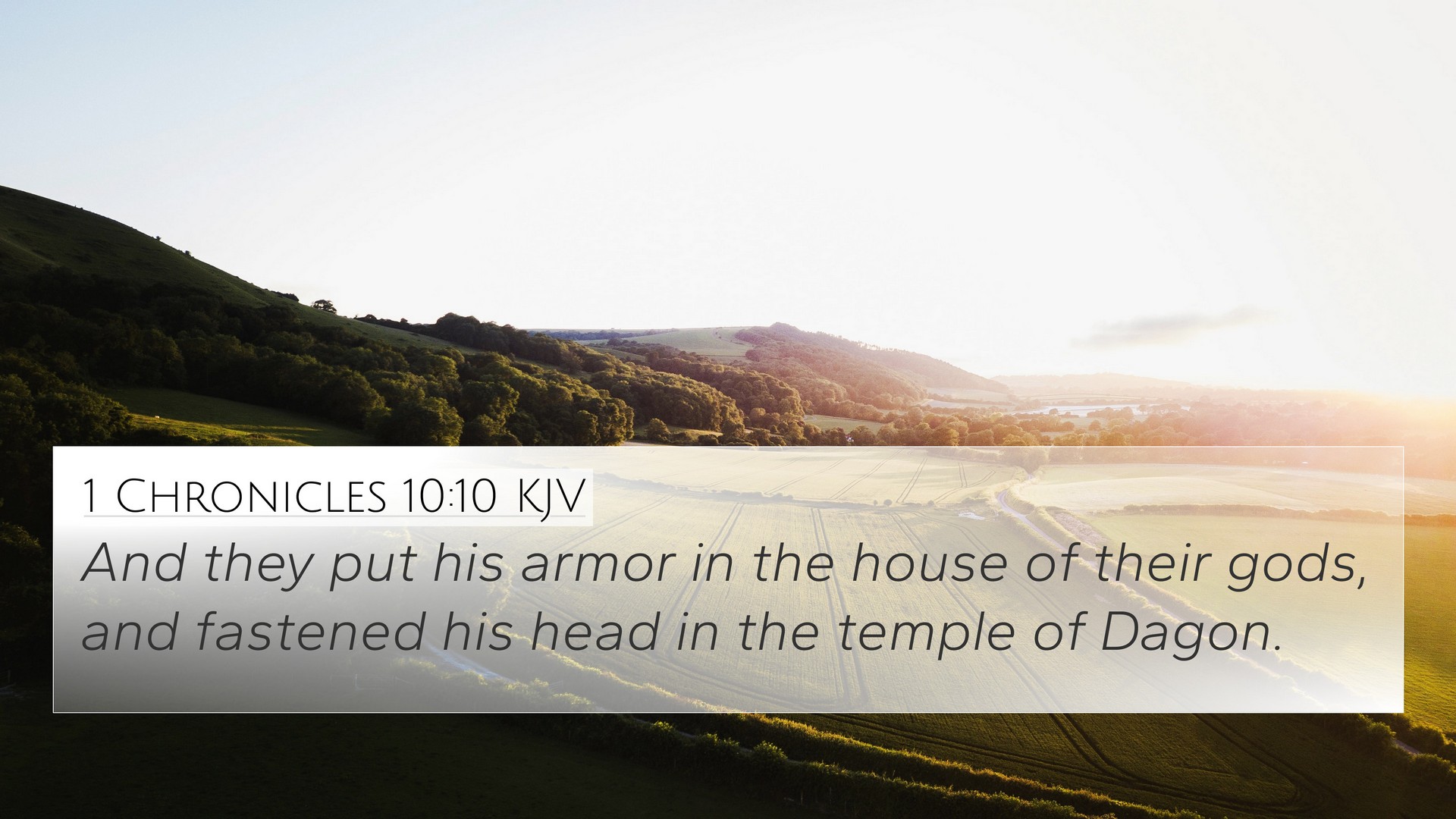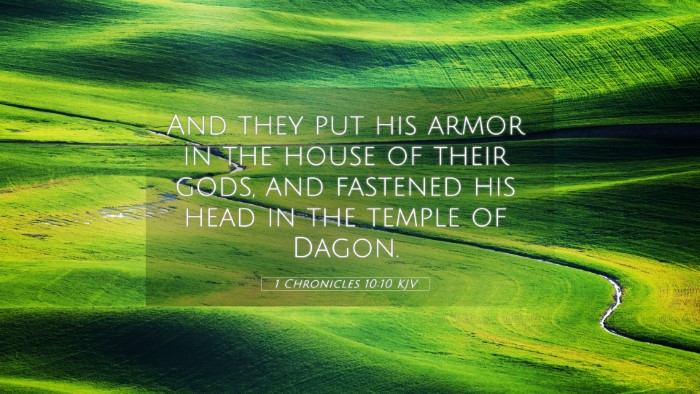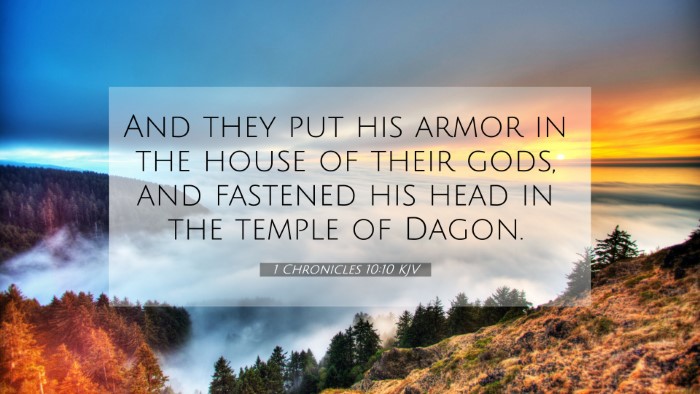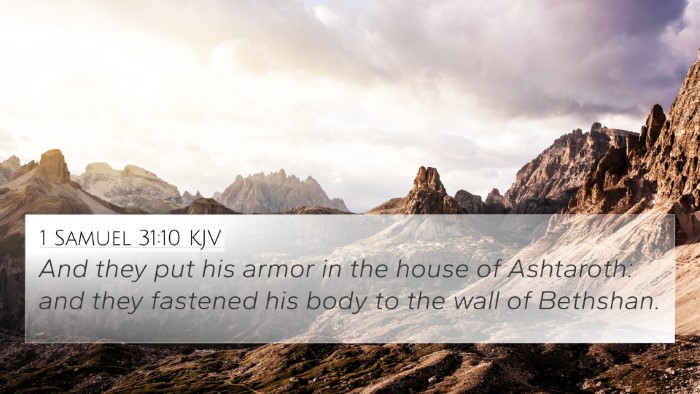Understanding 1 Chronicles 10:10
1 Chronicles 10:10 states: “And they put his armor in the house of their gods, and fastened his head in the temple of Dagon.” This verse describes an important moment following the death of King Saul, highlighting the actions taken by the Philistines regarding Saul's armor and head. Below is a detailed interpretation of its significance based on insights from various public domain commentaries.
Verse Context and Overview
This verse occurs after the battle on Mount Gilboa, where Saul and his sons faced defeat against the Philistines. The Philistines, in their triumph, desecrate Saul's body by displaying his armor and decapitating him, which was a common practice to demonstrate victory and instill fear in enemies.
Commentary Insights
-
Matthew Henry's Commentary:
Henry emphasizes the humiliation that Saul suffered in death, contrasting it with his previous glory as king. The act of placing his armor and head in the temples signifies the Philistines' contempt for the God of Israel, indicating their belief that Dagon had delivered Saul into their hands. This act illustrates not just a physical victory but a spiritual affront, highlighting the ongoing battle between the gods of surrounding nations and the God of Israel.
-
Albert Barnes' Notes:
Barnes focuses on the implications of this act within the broader narrative of Israel’s history. He notes that such actions were intended to mock a defeated enemy and serve as cautionary tales for the living. The display of Saul’s decapitated head promotes a sense of fear among the Israelites and is indicative of the historical animosity between the Israelites and Philistines.
-
Adam Clarke's Commentary:
Clarke discusses the cultural practice of displaying the defeated enemy's armor and head, interpreting it as an expression of dominance by the Philistines. He highlights the significance of Dagon, a fish deity, symbolizing the pagan worship that stood in stark opposition to the monotheistic worship of Israel. This moment foreshadows the eventual return of Saul's remains and the burial honors that would be rendered in Israel, restoring dignity to his family and nation.
Thematic Connections
This verse relates to several themes within the Bible, notably the tension between different spiritual forces, the consequences of disobedience, and the ultimate sovereignty of God. The Philistines' actions serve to reflect their belief systems while also starkly highlighting Israel's vulnerability and need for repentance.
Cross-Referencing Biblical Texts
To gain a deeper understanding of 1 Chronicles 10:10, here are some related Bible verses that can be cross-referenced:
- 1 Samuel 31:9-10: This passage describes the death of Saul and the immediate actions taken by the Philistines.
- 2 Samuel 1:10: The account of an Amalekite who claimed to have killed Saul, illustrating the confusion in the narrative surrounding Saul's death.
- 1 Chronicles 10:1: The introduction of Saul's defeat over the Philistines is crucial for understanding this context.
- 1 Samuel 17:46-47: David's confrontation with Goliath highlights the longstanding conflict between the Israelites and Philistines.
- Jeremiah 25:9: This verse talks about the judgment against nations, including Philistia, showing God's ultimate control over history.
- Psalm 115:5-8: Reflecting on the futility of idols, which relates to the deities like Dagon, ridiculed in the face of God’s sovereignty.
- 1 Samuel 8:20: This verse foreshadows Israel's demand for a king, setting the stage for Saul's reign and subsequent downfall.
Conclusion
In summary, 1 Chronicles 10:10 serves as a poignant reminder of the consequences of leadership and the importance of faithfulness to God. The actions of the Philistines not only illustrate their animosity towards Israel but also serve as a stark contrast to the divine support that Israel could have received had they remained faithful. Cross-referencing this verse with others in the Scriptures enriches one's understanding of the complex narrative that unfolds concerning Saul's tragic end, the ongoing spiritual battle in biblical history, and the ultimate hope found in God's sovereignty.




